Abstract
Fiber-reinforced plastic (FRP) composite laminates have excellent mechanical properties, corrosion resistance, and designability and thus are widely used in various engineering fields. However, their interlayer performance is relatively poor due to no fiber reinforcement between the laminate layers. These layers are adhered through resin bonding only, caused during their usage, which results in composite material delamination damage, thus, limiting its performance. In response, researchers have conducted numerous studies on how to improve the interlaminate properties of laminates through component and structural modifications of the composites and interlaminate toughening. Short fiber toughening is a simple and effective way to solve this problem. This paper reviews the latest research progress in short fiber interlaminate toughening and short fiber modified resin toughening, analyzes the mechanisms of short fiber toughening is fiber bridging, fiber debonding, fracture, and the toughening mechanisms specific to different fibers. This review paper also discusses the current problems encountered in short fiber toughening and provides an outlook on the future development direction for short fiber toughening to provide a reference for subsequent research on short fiber toughened composites.
1. Introduction
Fiber-reinforced plastic (FRP) composite laminates are widely used in the aerospace field [1], automotive industry [2], wind power generation [3], and civil infrastructure [4] because of their lightweight and relatively high strength characteristics. However, as the laminates are bonded by resin only in the thickness direction, they are prone to cracking and eventually delamination under the action of external forces [5]. Delamination damage limits the development of composite materials as it seriously affects their safety performance and service life. Much work has been carried out to suppress delamination and increase damage tolerance, including Z-directional toughening (3D braiding [6,7,8,9], Z-pinning [10], laminate stitching [11], and 3D integrated woven spacer sandwich composites [12,13]), matrix modification [14], and interlaminate toughening [15]. Z-directional toughening, which introduces a separate yarn system in the Z-direction of the composite, has been shown to significantly improve interlaminar fracture toughness [16], but this may come at the cost of compromising the in-plane properties and is difficult to operate. Interlayer toughening and resin modification requires only minor changes to conventional processes for toughening purposes but use materials such as nanofilms and nanoparticles, which require high costs.
Short fibers are a variety of sources, excellent performance, and inexpensive materials that can be added to laminate plies alone for interlaminar toughening or mixed in resin to modify the resin matrix, which can simply and effectively improve the interlaminar strength of composites. This paper presents the research in recent years on two aspects of short fiber interlaminate toughening and short fiber resin modification.
2. Interlaminar Fracture Toughness Characterization and Testing of Composite Laminates
According to the different forms of load, the composite laminate delamination mainly has the types: opening mode (mode I), sliding mode (mode II), and tearing mode (mode III). The three forms of delamination, as shown in Figure 1, of which mode III delamination is less studied, account for a negligible fraction [17,18]. Interlaminar fracture toughness (ILFT) is a quantitative measure of the ability of composite laminates to resist crack extension and an estimate of material toughness. The stress-based stress intensity factor K [19] and the strain-based strain energy release rate G [20] are often used to characterize delamination extension. Since composites are materials with anisotropic mechanical properties, the calculation of the stress intensity factor K for interlaminar cracks is particularly complicated, so most of the studies are conducted using the strain energy release rate G as the control parameter for delamination expansion. The strain energy release rate is the strain energy released per unit area of crack growth of the deformed object, and its critical value is called the critical strain energy release rate, expressed by the symbol GC, which indicates the energy required for crack expansion per unit area; generally, there is the mode I (GIC) and mode II (GIIC) [21]. From the ASTM standard, it is known that the mode I and mode II ILFT of composites is mainly obtained by the double cantilever beam (DCB) test [22] and end notched flexure (ENF) test [23], with the test setup diagram in Figure 2. The ILSS testing [24] is a popular method for characterizing the interfacial strength of composite materials. Composites are very sensitive to low-velocity impact loading in practical applications, so the low-velocity impact test [25] and compression after impact (CAI) test [26] are also often used together to characterize the resistance of composites to delamination when subjected to low-velocity impacts.
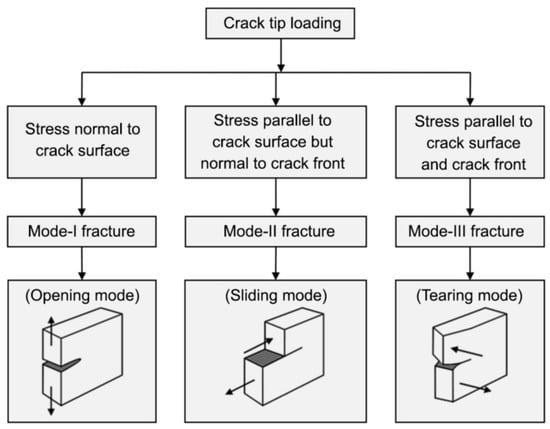
Figure 1.
Modes of fracture [18].
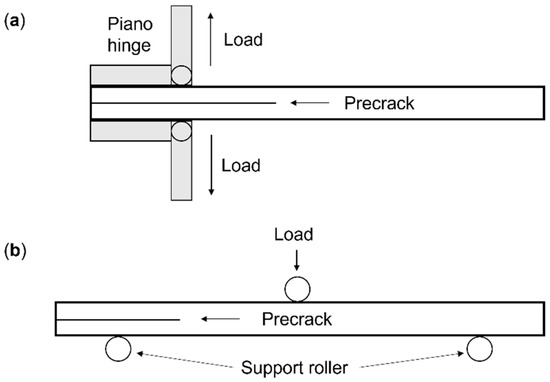
Figure 2.
Schematic diagrams of (a) double cantilever beam (DCB) test and (b) end notch flexure (ENF) test.
3. Short Fiber Toughening
3.1. Short Fiber Interlayer Toughening
In the 1990s, Sohn and Hu covered the surface of carbon fiber prepreg with chopped aramid fibers that accounted for 0.4% to 0.8% of the weight of the laminate and then cured it according to the conventional process. It was found that the addition of short fibers could produce fiber bridging during delamination extension to improve the mode I (GIC) and mode II (GIIC) interlaminar fracture toughness of the laminate by up to more than two times [27]. Since then, more scholars have begun to study short fibers as interlaminar toughening materials to improve the interlaminar fracture toughness of composites [28,29,30,31,32]. Liu et al. investigated the effect of three basic factors on the interlaminar fracture toughness of CF/EP composites using three-factor four-level orthogonal tests, as in Table 1, which are short fiber type, length, and density [33]. The results showed that the effects of each factor on the ILFT were in the order of fiber type, fiber density, and fiber length. The addition of Kevlar fiber most significantly enhanced GIC and GIIC; with the increase of short fiber density, GIC showed a positive correlation, and GIIC showed a decreasing and then increasing trend. Both GIC and GIIC tend to increase as the length of the staple fiber increases and tend to decrease when the length is too long. This provides some reference for future studies in terms of material selection and dosage, but the authors do not further analyze how length and density affect the interlaminar fracture properties.

Table 1.
Orthogonal test table (Data from [33]).
Aramid fibers (AF) have the characteristics of high toughness, high elongation at break, and easy fibrillation on the surface [34]. Under the action of fiber bridging, the deformation and longitudinal tear of the fiber itself can absorb a lot of energy, which plays a very good role in toughening effect [35]. Wang et al. studied the interfacial toughness of CFRP reinforced by short aramid fibers with different lengths and areal densities based on the double cantilever beam test [36]. The results showed that the short aramid fibers with a length of 3 mm and an areal density of 24 g/m2 had the best toughening effect, the ultimate load, and the mode I interlaminar fracture toughness can be increased by 292.87% and 168.59%, respectively. To ensure the feasibility and effectiveness of aramid fiber interlaminar toughening CFRP, they adopted wettability treatment technology with resin pre-coating to treat short aramid fiber tissues (6 mm, 24 g/m2), and the peak load and GIC of CFRP were increased by 112%, and 160%, respectively. The pre-coating contributed 37% and 56% improvement, respectively [37]. This explains that the toughening ability of short Kevlar fibers of 3 mm is stronger than 6 mm at the same surface density. This provides a simple way to improve the interfacial compatibility of fibers and resins and also demonstrates that modification of short fibers can further improve the toughening effect.
To enable the short fibers to be evenly dispersed between the layers, Hu et al. impregnated chopped Kevlar fibers in the resin and uniformly coated them on the mid-plane of the laminate. The laminate structure is shown in Figure 3. The effect of chopped Kevlar fiber toughening on the low-speed impact performance of CFRP through drop-weight impact test and compression after impact (CAI) test was studied [38]. The test results showed that the damage resistance of the toughened laminate did not show significant advantages at lower impact energies, and the effect of short fiber toughening was shown only at higher energy impacts. However, the CAI strength and damage strain values increased at all energy levels because the pullout of the chopped fibers consumed part of the energy in delamination expansion under compressive loading, slowing down the yielding process and increasing the CAI strength. The authors considered that short Kevlar fiber toughening is very effective in increasing the damage tolerance when the damage is dominated by mode I fracture toughness.

Figure 3.
Structure of composite laminate with Kevlar-fiber toughening. The sandwich structure was adopted, with a carbon fiber prepreg sheet at the top and bottom and a Kevlar-fiber layer in the middle [38].
It is believed that adding short fibers to the interlayer is only beneficial to post-impact properties. Still, the interfacial staggering leads to a decrease in the flexural properties of CFRP. Yuan et al. placed an ultra-thin nonwoven short aramid fiber veil (UTNWSAFV) at the interface of all layers of CFRP laminates and found that not only the impact resistance of CFRP could be improved, but also the flexural strength and modulus were improved accordingly [39]. They prepared a toughened prepreg by interweaving the unbonded UTNWSAFV to the surface of the carbon fiber layer in the prepreg production process [40]. Impact tests and compression after impact tests showed that adding UTNWSAFV can effectively suppress out-of-plane deformation and layered expansion. The CAI failure pattern of the laminate with SAFV was changed from delamination damage to shear damage, as seen in Figure 4. The addition of short fibers to the prepreg production process to create short fiber toughened prepreg is a promising technology that focuses on how the short fibers are added to the prepreg in large quantities and uniformly, as this has a major impact on the stability of the composite properties.
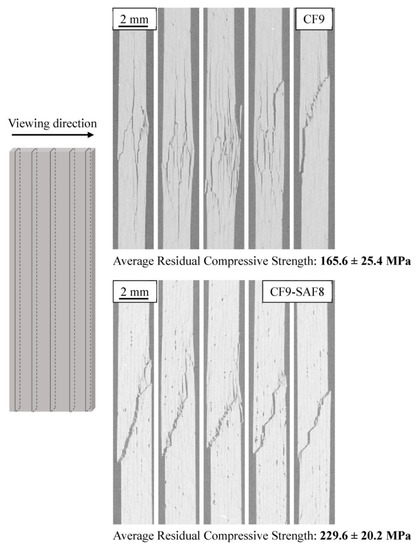
Figure 4.
CAI test failure morphology of CF9 and CF9-SAF8 (X-ray µCT) [40].
Carbon fibers (CF) have high strength and modulus and are often used to make composite materials. Due to their excellent properties, chopped carbon fibers are also used as interlaminar toughening materials to improve the fracture toughness of composites. Xu et al. compared the interlaminar fracture toughness and bending properties of CF/EP composites toughened with two lengths of chopped carbon fibers [41]. It showed that the shorter (0.8 mm) carbon fiber performed better than the longer (4.3 mm) carbon fiber in improving mode I fracture toughness. The longer carbon fiber contributed more to mode II fracture toughness, which was achieved without compromising the bending mechanical properties. Short carbon fibers easily form a three-dimensional interwoven network structure in the epoxy resin of the middle layer of the laminate, and this structure can play a better role in obstructing cracks, as shown in Figure 5. Moreover, due to the addition of short carbon fibers, the electrical conductivity in the thickness direction of the carbon fiber laminates has been improved. According to this conclusion, different lengths of staple fibers can be selected for selective toughening, depending on the form of loading the laminate is subjected to.
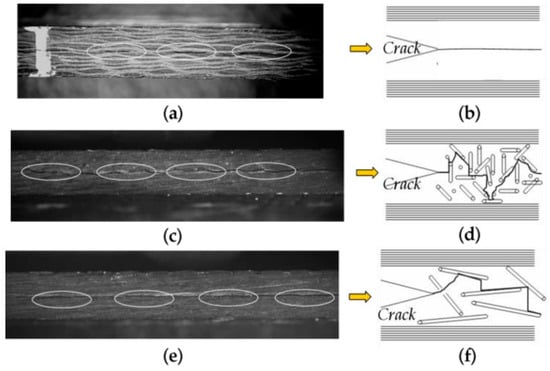
Figure 5.
The crack propagation path in the mid-layer of laminates during Mode I DCB tests: (a,b) pure; (c,d) SCFs (7.8 mg/cm2) and (e,f) LCFs (7.8 mg/cm2) [41].
To improve the lightning strike resistance of composite materials, Liu et al. bonded chopped nickel-coat carbon fibers (NiCF) together with adhesive to make a NiCF veil, which was used as a multifunctional toughening layer for CFRP [42]. It is shown that the multifunctional NiCF veil can not only improve the interlayer fracture toughness of CFRP, which can increase the GIC by 74.75% and GIIC by 36.22%, but also improve the electrical conductivity in the thickness direction by 220.49%. Its toughening mechanisms include debonding and fracture of NiCF, as well as flaking and splitting of the nickel coating. The above study shows that the rupture and debonding of the coating absorbs additional energy to improve the interlaminar fracture toughness of the composite without losing the interfacial compatibility of the short fibers and the resin. Du et al. used CNT grafted short carbon fibers as interlaminar toughening materials for CF/EP composites, and the type I interlaminar fracture energy of CFRP could be increased by 125% when the density of CNT-SCF was 10 g/m2 [43]. Of particular note, he investigated the crack damage sensing ability of toughened CFRP composites using a simple electrical response method using an experimental setupand the results showed that the change in resistance increased monotonically with cracking, which provides a new method for measuring crack extension.
Ma et al. produced five different structures of short glass fiber interlayer toughened GF/EP composites by the VARTM process, as shown in Figure 6 [44]. The experimental results showed that the interlaminar tearing performance of the short glass fiber toughened composites was significantly enhanced, and the toughening effect was most evident for structures B and C, and the shorter the glass fibers, the better the toughening result. This research indicates that in addition to fiber type, length, and content, the arrangement of short fibers between the layers should also be considered, which is an important factor affecting the mechanical properties of toughened composites.
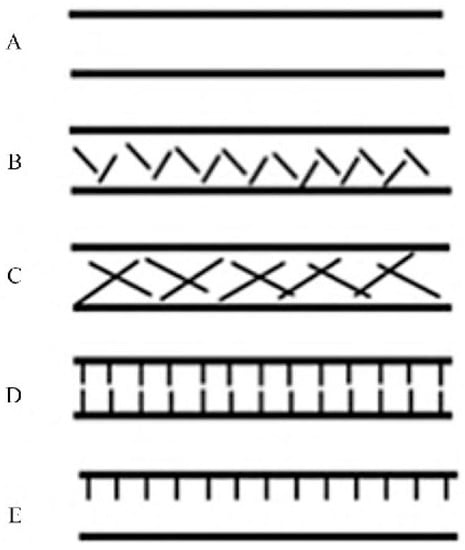
Figure 6.
Five kinds of reinforcement structure (A): two layers of plain glass fiber fabric without short fibers; (B,C): short fibers are randomly distributed between the layers; (D): two layers of fabric containing short fibers; (E): one layer of fabric containing short fibers and one layer of plain glass fiber fabric) [44].
While environmental problems are a growing concern in today’s society, natural fibers have the advantages of sustainability, biodegradability, and lower cost, which allows them to replace some synthetic fibers in the manufacture of composite materials [45,46,47,48,49,50,51,52,53,54]. It is worth establishing that short natural fibers are a potential interlayer toughening material. Jeong et al. covered short silk fiber within two resin films, placed them in the middle of CFRP prepreg for normal curing, and evaluated mode I and mode II fracture toughness by DCB and ENF tests [55]. The test results showed that the addition of silk was useful in improving the interlaminar fracture toughness of the laminate. The mode I interlaminar fracture toughness was 59% higher compared with the untoughened laminate, the main factors for the increase being the adhesion force on the silk fibers to the epoxy matrix and the relatively high tensile strength of the silk fibers; mode II interlaminar fracture toughness increased by 44%, mainly because the bridging and fracture of the silk fibers inhibited the crack expansion. If spun silk can be processed and appropriately used, it will not only improve the mechanical properties of the composite material but also avoid the waste of raw materials.
The feasibility of interlaminar toughening of CF/EP composites with short ramie fiber (SRF) was demonstrated by Mo et al. [56]. The SRF layer effectively hindered the crack expansion in the matrix and significantly improved the interlaminar fracture toughness of the composite laminates. The toughening mechanism of SRF can be analyzed from the type II interlaminar fracture microscopic morphology shown in Figure 7: firstly, the fracture surface becomes rougher, which increases the surface area of the fracture surface of the composite material and requires more energy to be consumed during crack propagation; secondly, the SRF bridging in the composite absorbs the energy of the crack tip, which effectively hinders the crack propagation in the matrix; furthermore, the SRF pulling and splitting from the matrix also needs to absorb a certain amount of energy. At the same time, the tensile and bending properties of the composites have been raised to a certain extent. They also treated SRF with surface coupling agents, which proved to be effective in improving the fracture toughness of the composites.
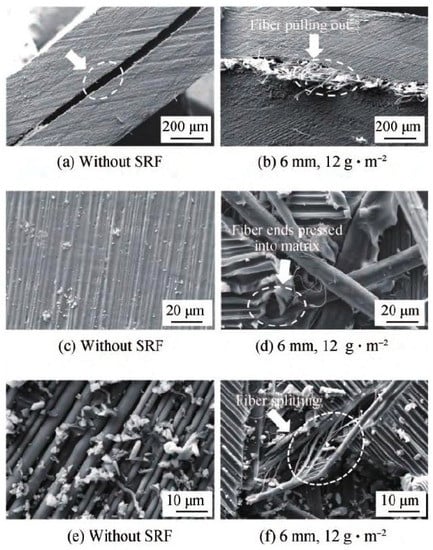
Figure 7.
Mode II interlaminar fracture morphology of CF/EP composite laminate specimens without and with SRF [56].
Zheng et al. compared the toughening effect of short flax fiber, short carbon fiber, and short Kevlar fiber interlayer toughened CF/EP composites, and the test results showed the toughening effect of short flax fiber was between short carbon fiber and short Kevlar fiber [35]. The reason is that the multi-layer level damage of the fiber itself occurs during the crack extension, which absorbs additional energy and further improves the toughening effect. Li et al. investigated the impact of chopped flax yarns (CFY) on the mode I interlaminar fracture toughness of flax fiber/epoxy composites. The experimental results showed that the mode I fracture toughness of the composites increased with the addition of CFY [57]. The CFY layer hindered the crack expansion and led to more energy consumption in the delamination process, but excessive yarn length and content direct unstable crack extension, weakening the toughening effect. When the yarn length and content are moderate (10 mm, 20 g/m2), the toughening effect is the best, and the GIC is increased by 31%. Zhang et al. proposed a multiscale cellulose fiber interlayer consisting of chopped flax fibers (CFF) and cellulose nanofibers (CNF) to improve the interlayer fracture toughness of CF/EP composites [58]. The results showed that the addition of cellulose fiber interlayer could significantly improve the mode II interlaminar fracture toughness due to the synergistic effect of CFF and CNF, and the toughening mechanism can be seen in Figure 8, which includes fiber bridging, fiber pullout, fiber fracture, and the fibrillation of flax fiber. The existence of CNF can improve the interfacial compatibility between CFF and epoxy resin matrix, which is conducive to the fibrillation of flax fibers and hinders the propagation of interlaminar cracks. Obviously, flax fibers, due to their multi-layered structure, can absorb more energy, which is unique to toughening unlike other fibers mechanism. The price of flax fiber compared to aramid, carbon fiber, and others is lower, but there is a very good toughening effect, which is a cost-effective toughening material.
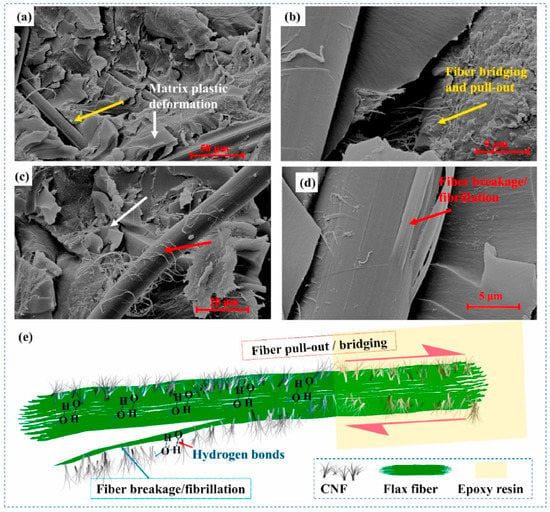
Figure 8.
(a–d) Fracture morphologies and (e) toughening mechanism of CNF/FF-interleaved CFRPs [58].
Numerous experiments have demonstrated that short fiber interlaminate toughening is an effective method to improve the interlaminate fracture toughness of composite laminates. Still, many unknown influences on the short fiber interlaminate toughening technique can be affected by factors such as the thickness, dispersibility, geometry, and final cure shape of the short fiber layup and fiber type length and surface density. Instead of limiting themselves to adding short fibers to the layers by simple hand-spreading, researchers have developed methods such as making nonwovens, muslins, films, and blending in resins, all of which are designed to eliminate the effects of uneven distribution of short fibers between the layers [59]. If the effects of these factors can be balanced and allow for the control and manipulation of delamination damage, this will achieve the goal of preparing higher performance, more damage-resistant composites.
Natural fibers are also starting to be used in composite interlayer toughening because of their high-cost performance, but the natural fibers are not as good as the synthetic fibers, which limits their large-scale promotion. The hybrid short fiber interlayer toughening is a method that should be considered for interlayer toughening, which can reduce the cost and make up for the shortage of single-type short fiber toughening.
3.2. Short Fiber Modified Resin Toughening
Another way to improve the toughness of FRP is to modify the resin matrix, and it has been shown that nanoparticles are very good toughening agents, such as nano titanium dioxide [60], nano clay [61], multi-walled carbon nanotubes [62], etc. Nanoparticles have strong chemical activity and can fully bond with epoxy resin to form an ideal interface to blunt cracks and hinder crack expansion from achieving toughening while improving modulus and heat resistance. However, nanomaterials are easy to agglomerate in the resin matrix, unfavorable to operation and processing, and nanoparticles are usually relatively high in cost, which limits their application to some extent [63].
Short-fiber toughened resins offer a viable, low-cost method for resin modification. Chawla et al. prepared unidirectional glass fiber/epoxy laminates from two different resins, one pure and the other containing 2% volume fraction short glass fiber reinforcement, and performed DCB tests [64]. The experimental results showed that fiber bridging was observed in the laminates with the presence of short fibers and that the toughened laminates increased GIC by about 19.6% compared to the untoughened laminates. Imagawa et al. added 0.3 wt% weight content of micro-glass fibers to thermoplastic epoxy resin and thermoset epoxy resin to make CFRP and conducted ENF tests [65]. The results showed that the addition of glass fibers increased fiber bridging to prevent crack extension and improved the GIIC of composite regardless of the resin. Fiber bridging was observed in all of these studies, and the toughness of the composites was improved, demonstrating the feasibility of short fiber-modified epoxy resin toughening.
Ravindran et al. prepared CFRP composite laminates by adding CNF, CSF, and CNF/SCF fillers to an epoxy resin matrix, and the experimental results showed that the addition of CNF or/and SCF fillers improved the delamination toughness, impact damage tolerance, and CAI strength of CFRP laminates without reducing their in-plane bending and interlaminar shear strength properties compared to CFRP laminates made with the unmodified epoxy resin matrix [66]. In terms of mode II fracture toughness, the multiscale short fiber toughening effect is better than the sum of CNF and CSF alone. Future research on multiscale toughening needs to focus on the synergistic effect of multiscale toughening, which is similar to hybrid fiber toughening. Dasari et al. investigated the role of short carbon fibers (SCFs) as secondary reinforcement in glass fiber/epoxy composites. They evaluated the effect of SCF concentration on the mechanical properties of GFRP by tensile, flexural, and interlaminar fracture toughness tests [67]. The results showed that when the SCF content was 0.1 wt%, the tensile and flexural strengths of the composites were increased by 29.02% and 16.08%, respectively. In mode I and mode II interlaminar fracture toughness tests, the samples with 0.1 wt% exhibited the highest strain energy release rate, with an increase of 13.49% and 20.45% in GIC and GIIC, respectively. They prepared glass fiber composites (SGF-GE) by modifying epoxy resin with short glass fibers of 2–5 mm at different concentrations, and the results of three-point bending tests showed that the short fibers as secondary reinforcement could improve the flexural strength and flexural modulus of the composites [68]. Yu et al. mixed short basalt fibers (SBF) in unsaturated polyester (UP) resin and then coated them in the middle of basalt fabric curing molding to make BF/UP composites. The results showed that SBF had an excellent toughening effect on BF/UP, including mode II interlaminar fracture toughness, tensile strength, elongation at break, bending strength, and energy absorption were significantly enhanced [69]. From these studies, it can be seen that the addition of very small amounts of short fibers not only improves the interlaminar fracture toughness of the composite but also the in-plane properties to a greater or lesser extent. This is further evidence of the feasibility and superiority of short fiber-modified resin toughening.
The use of recycled fibers to manufacture useful engineered composite components is a current research trend and requirement to protect the environment and save costs. Cholake et al. modified epoxy resin by recycled short-milled carbon fiber, 5 wt% and 10 wt% of SMCF could increase the GIC of epoxy matrix by 261% and 692%, respectively. The GIC of ground laminate using modified epoxy resin was increased by 50% and 64%, respectively, which proved to be a low-cost and effective method to toughen CFRP [70]. Saravana Kumar et al. investigated the effect of milled glass fibers filler on the interlaminar fracture toughness of GF/EP composites. They showed that the fracture toughness of mode I and mode II could be maximized by adding 5 wt% milled glass fibers by 102% and 175%, respectively, while the bending strength was also enhanced [71]. The interlaminar fracture toughness of composites can be effectively improved by adding recycled short fiber fillers. Still, fiber recycling is a very big topic, and it is of great concern to ensure that the recycled fibers have less property damage that may affect its toughening effect.
Graphene oxide (GO) is commonly used to treat fibers to improve the interfacial properties of composites [72]. Dang et al. used GO-modified short glass fibers to improve the ILSS of GF/EP composites. The experimental results showed that GO significantly increased the surface roughness of SGFs and improved the interfacial adhesion between SGFs and EP, while GO-SGFs could improve the ILSS of GF/EP composites by 18.4% [73]. Nie et al. added short carbon fibers treated with ethanol and concentrated nitric acid to the epoxy matrix for the ILSS improvement of CF/EP composites, and the preparation process of the composites is shown in Figure 9a [74]. The ILSS testing showed that adding oxidized short carbon fibers equivalent to a very low epoxy resin content could effectively improve the ILSS. They also prepared GO-SCF by a simple aqueous solution method, as shown in Figure 9b, and studied the effect of GO-SCF toughening resin on the ILSS of CF/EP composites, which showed that the ILSS of composites containing GO-SCF was higher than that of SCF at the same SCF content because GO increased the bonding force between SCF and epoxy resin, and GO-SCF could increase the ILSS by up to 14.7% [75]. The authors concluded that this method has practical application in improving the interlaminar shear properties of CF/EP composites due to the low cost and easy processability of SCF.
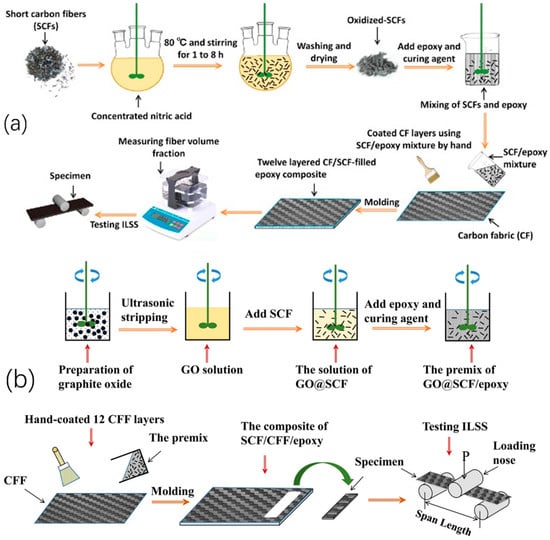
Figure 9.
Schematic diagrams of preparation and mechanical testing of (a) oxidized SCF/CFF/EP composites; (b) GO@SCF/CFF/EP composites [74,75].
As stated in the literature [71], until the problem of agglomeration of short fibers in the resin is solved, only a limited amount of short fibers can be added to the resin, and this method cannot be used on a large scale yet.
4. Conclusions
This paper reviews the enhancement of composite interlaminar fracture toughness and other mechanical properties by incorporating short fibers in the composite preparation. In summary, short fiber interlaminar toughening techniques and short fiber modified resins can effectively improve the interlaminar fracture toughness of composites. Short fiber interlaminate toughening is specifically designed to improve the interlaminate properties of laminates. It is highly targeted to improve the interlaminate properties of laminates; short fiber modified resin toughening can improve the interlaminate properties and improve the in-plane properties. By adding a small number of short fibers, improving the interlaminar fracture toughness of composites without damaging other properties can be achieved. For different toughening methods, the toughening mechanism of short fibers is discussed. The toughening mechanisms are fiber bridging to hinder crack expansion, fiber debonding, and fracture from consuming additional energy and specific to different fibers and methods.
5. Prospect
It is not difficult to find that the short fibers are randomly distributed in the composite during the experiment, which brings many uncertainties to the short fiber toughening. If the short fibers can be oriented and arranged to eliminate the uncertainties of random distribution, it may make short fiber toughening stable and applicable.
Moreover, the issue of the source of staple fibers is also an issue worth considering; with the development of a low-carbon economy, natural fibers and recycled fibers have gradually become the hotspot of composite materials. Reasonable use of these fibers as toughening materials can reduce costs on the one hand and reduce environmental damage and waste of resources on the other hand. However, these fibers may have deficiencies in performance compared to synthetic fibers, so hybridization with synthetic fibers should be considered.
Hybrid fiber composites can make up for the shortcomings of single fiber composites, especially the hybrid of synthetic fibers and natural fibers, which is the trend of composite material development [76,77]. There are few research reports on hybrid short fiber toughened composites. Further research is needed to verify the feasibility and effectiveness of hybrid short fiber toughening and explore the mechanism of hybrid toughening.
Author Contributions
Conceptualization, L.Z.; supervision of the study, L.Z.; Funding acquisition, L.Z.; investigation, Y.W.; data curation, Y.W.; writing—original draft preparation, Y.W.; writing—review and editing, L.Z. and Z.W. All authors have read and agreed to the published version of the manuscript.
Funding
This research was funded by the Zhejiang Provincial Natural Science Foundation of China under Grant No LGG21E050025, the Fundamental Research Funds of Zhejiang Sci-Tech University (Project Number: 20202113-Y), as well as the Fundamental Research Funds of Shaoxing Keqiao Research Institute of Zhejiang Sci-Tech University (Project Number: KYY2021001G).
Institutional Review Board Statement
Not applicable.
Informed Consent Statement
Not applicable.
Data Availability Statement
Not applicable.
Conflicts of Interest
The authors declare no conflict of interest.
References
- Aamir, M.; Tolouei-Rad, M.; Giasin, K.; Nosrati, A. Recent Advances in Drilling of Carbon Fiber-Reinforced Polymers for Aerospace Applications: A Review. Int. J. Adv. Manuf. Technol. 2019, 105, 2289–2308. [Google Scholar] [CrossRef]
- Alshahrani, H.; Ahmed, A. Enhancing Impact Energy Absorption, Flexural and Crash Performance Properties of Automotive Composite Laminates by Adjusting the Stacking Sequences Layup. Polymers 2021, 13, 3404. [Google Scholar] [CrossRef] [PubMed]
- Zangenberg, J.; Brondsted, P.; Koefoed, M. Design of a Fibrous Composite Preform for Wind Turbine Rotor Blades. Mater. Des. 2014, 56, 635–641. [Google Scholar] [CrossRef]
- Ullah, H.; Harland, A.R.; Silberschmidt, V.V. Dynamic Bending Behaviour of Woven Composites for Sports Products: Experiments and Damage Analysis. Mater. Des. 2015, 88, 149–156. [Google Scholar] [CrossRef] [Green Version]
- Ouyang, T.; Sun, W.; Bao, R.; Tan, R. Effects of Matrix Cracks on Delamination of Composite Laminates Subjected to Low-Velocity Impact. Compos. Struct. 2021, 262, 113354. [Google Scholar] [CrossRef]
- Wang, J. Research on Properties of Three-dimensional UHMWPE Fiber Composite with Difference Structures. Adv. Text. Technol. 2021, 29, 12–17. [Google Scholar] [CrossRef]
- Tao, N.; Gao, X. Research on Interface Modification and Bend of 3D Orthogonal Woven Glass Fiber Composites. Adv. Text. Technol. 2019, 27, 12–18. [Google Scholar] [CrossRef]
- Shen, X.; Liu, X.; Tian, W.; Zhu, C. Study on Mechanical Properties of Orthogonal and Quasi-Orthogonal 3D Woven Composite with Combined Structure. Adv. Text. Technol. 2019, 27, 6–11. [Google Scholar] [CrossRef]
- Hu, Q.; Memon, H.; Qiu, Y.; Liu, W.; Wei, Y. A Comprehensive Study on the Mechanical Properties of Different 3D Woven Carbon Fiber-Epoxy Composites. Materials 2020, 13, 2765. [Google Scholar] [CrossRef]
- Liao, B.; Zhou, J.; Zheng, J.; Tao, R.; Xi, L.; Zhao, T.; Li, Y.; Fang, D. Effect of Z-Pin Inclined Angle on the Impact Damage Suppression Effectiveness for Cross-Ply Composite Laminates. Compos. Pt. A-Appl. Sci. Manuf. 2021, 142, 106264. [Google Scholar] [CrossRef]
- Drake, D.A.; Sullivan, R.W.; Lovejoy, A.E.; Clay, S.B.; Jegley, D.C. Influence of Stitching on the Out-of-Plane Behavior of Composite Materials—A Mechanistic Review. J. Compos Mater. 2021, 55, 3307–3321. [Google Scholar] [CrossRef]
- Zhu, L.; Bin Rahman, M.; Wang, Z. Effect of Structural Differences on the Mechanical Properties of 3D Integrated Woven Spacer Sandwich Composites. Materials 2021, 14, 4284. [Google Scholar] [CrossRef] [PubMed]
- Bin Rahman, M.; Zhu, L. Low-Velocity Impact Response on Glass Fiber Reinforced 3D Integrated Woven Spacer Sandwich Composites. Materials 2022, 15, 2311. [Google Scholar] [CrossRef] [PubMed]
- Ning, N.; Wang, M.; Zhou, G.; Qiu, Y.; Wei, Y. Effect of Polymer Nanoparticle Morphology on Fracture Toughness Enhancement of Carbon Fiber Reinforced Epoxy Composites. Compos. Pt. B-Eng. 2022, 234, 109749. [Google Scholar] [CrossRef]
- Saghafi, H.; Palazzetti, R.; Heidary, H.; Brugo, T.M.; Zucchelli, A.; Minak, G. Toughening Behavior of Carbon/Epoxy Laminates Interleaved by PSF/PVDF Composite Nanofibers. Appl. Sci.-Basel 2020, 10, 5618. [Google Scholar] [CrossRef]
- Hu, Q.; Memon, H.; Qiu, Y.; Wei, Y. The Failure Mechanism of Composite Stiffener Components Reinforced with 3D Woven Fabrics. Materials 2019, 12, 2221. [Google Scholar] [CrossRef] [Green Version]
- Shrivastava, R.; Singh, K.K. Interlaminar Fracture Toughness Characterization of Laminated Composites: A Review. Polym. Rev. 2020, 60, 542–593. [Google Scholar] [CrossRef]
- Sharma, P.; Mali, H.S.; Dixit, A. Mechanical Behavior and Fracture Toughness Characterization of High Strength Fiber Reinforced Polymer Textile Composites. Iran. Polym. J. 2021, 30, 193–233. [Google Scholar] [CrossRef]
- Irwin, G.R. Structural Aspects of Brittle Fracture. Appl. Mater. Res. 1964, 3, 65–81. [Google Scholar]
- Griffith, A.A. The Phenomena of Rupture and Flow in Solids. Philos. Trans. R. Soc. A Math. Phys. Eng. Sci. 1920, A221, 163–198. [Google Scholar] [CrossRef]
- Dikshit, V.; Bhudolia, S.; Joshi, S. Multiscale Polymer Composites: A Review of the Interlaminar Fracture Toughness Improvement. Fibers 2017, 5, 38. [Google Scholar] [CrossRef] [Green Version]
- Standard Test Method for Mode I Interlaminar Fracture Toughness of Unidirectional Fiber-Reinforced Polymer Matrix Composites. Available online: https://www.astm.org/d5528_d5528m-21.html (accessed on 3 May 2022).
- Standard Test Method for Determination of the Mode II Interlaminar Fracture Toughness of Unidirectional Fiber-Reinforced Polymer Matrix Composites. Available online: https://www.astm.org/d7905_d7905m-19e01.html (accessed on 3 May 2022).
- Standard Test Method for Short-Beam Strength of Polymer Matrix Composite Materials and Their Laminates. Available online: https://www.astm.org/d2344_d2344m-16.html (accessed on 3 May 2022).
- Standard Test Method for Measuring the Damage Resistance of a Fiber-Reinforced Polymer Matrix Composite to a Drop-Weight Impact Event. Available online: https://www.astm.org/d7136_d7136m-20.html (accessed on 3 May 2022).
- Standard Test Method for Compressive Residual Strength Properties of Damaged Polymer Matrix Composite Plates. Available online: https://www.astm.org/d7137_d7137m-17.html (accessed on 3 May 2022).
- Sohn, M.-S.; Hu, X.-Z. Comparative Study of Dynamic and Static Delamination Behaviour of Carbon Fibre/Epoxy Composite Laminates. Composites 1995, 26, 849–858. [Google Scholar] [CrossRef]
- Park, B.Y.; Kim, S.C. A Study of the Interlaminar Fracture Toughness of a Carbon-Fiber/Epoxy Composite Containing Surface-Modified Short Kevlar Fibers. Compos. Sci. Technol. 1998, 58, 1599–1606. [Google Scholar] [CrossRef]
- Park, B.Y.; Kim, S.C.; Jung, B. Interlaminar Fracture Toughness of Carbon Fiber/Epoxy Composites Using Short Kevlar Fiber and/or Nylon-6 Powder Reinforcement. Polym. Adv. Technol. 1997, 8, 371–377. [Google Scholar] [CrossRef]
- Yadav, S.N.; Kumar, V.; Verma, S.K. Fracture Toughness Behaviour of Carbon Fibre Epoxy Composite with Kevlar Reinforced Interleave. Mater. Sci. Eng. B 2006, 132, 108–112. [Google Scholar] [CrossRef]
- Yasaee, M.; Bond, I.P.; Trask, R.S.; Greenhalgh, E.S. Mode I Interfacial Toughening through Discontinuous Interleaves for Damage Suppression and Control. Compos. Part A Appl. Sci. Manuf. 2012, 43, 198–207. [Google Scholar] [CrossRef]
- Yasaee, M.; Bond, I.P.; Trask, R.S.; Greenhalgh, E.S. Mode II Interfacial Toughening through Discontinuous Interleaves for Damage Suppression and Control. Compos. Part A Appl. Sci. Manuf. 2012, 43, 121–128. [Google Scholar] [CrossRef]
- Liu, W.; Li, W.; Ma, C.; Wang, S. Study on Properties of Interlayer Short Fiber Reinforced Carbon Fiber/Epoxy Composite Laminates. J. Phys. Conf. Ser. 2019, 1215, 012040. [Google Scholar] [CrossRef]
- Qi, G.; Zhang, B.; Du, S.; Yu, Y. Estimation of Aramid Fiber/Epoxy Interfacial Properties by Fiber Bundle Tests and Multiscale Modeling Considering the Fiber Skin/Core Structure. Compos. Struct. 2017, 167, 1–10. [Google Scholar] [CrossRef]
- Zheng, H.; Li, Y.; Tu, H. Research on Interlayer Properties of Short Fiber Intercalated Carbon Fiber/Epoxy Composites. Acta Mater. Compos. Sin. 2021, 1–13. [Google Scholar] [CrossRef]
- Wang, B.; Dong, N.; Ding, G. Mode I Interlaminar Fracture Toughness of CFRP Laminates Reinforced with Short Aramid Fibers. J. Adhes. Sci. Technol. 2020, 34, 2522–2536. [Google Scholar] [CrossRef]
- Wang, B.; Ding, G.; Wang, G.; Kang, S. Effects of Resin Pre-Coating on Interfacial Bond Strength and Toughness of Laminar CFRP with and without Short Aramid Fibre Toughening. J. Compos Mater. 2020, 54, 3883–3893. [Google Scholar] [CrossRef]
- Hu, Y.; Liu, W.; Shi, Y. Low-Velocity Impact Damage Research on CFRPs with Kevlar-Fiber Toughening. Compos. Struct. 2019, 216, 127–141. [Google Scholar] [CrossRef]
- Yuan, B.; Ye, M.; Hu, Y.; Cheng, F.; Hu, X. Flexure and Flexure-after-Impact Properties of Carbon Fibre Composites Interleaved with Ultra-Thin Non-Woven Aramid Fibre Veils. Compos. Pt. A-Appl. Sci. Manuf. 2020, 131, 105813. [Google Scholar] [CrossRef]
- Yuan, B.; Tan, B.; Hu, Y.; Shaw, J.; Hu, X. Improving Impact Resistance and Residual Compressive Strength of Carbon Fibre Composites Using Un-Bonded Non-Woven Short Aramid Fibre Veil. Compos. Pt. A-Appl. Sci. Manuf. 2019, 121, 439–448. [Google Scholar] [CrossRef]
- Xu, F.; Yang, B.; Feng, L.; Huang, D.; Xia, M. Improved Interlaminar Fracture Toughness and Electrical Conductivity of CFRPs with Non-Woven Carbon Tissue Interleaves Composed of Fibers with Different Lengths. Polymers 2020, 12, 803. [Google Scholar] [CrossRef] [Green Version]
- Liu, H.; Guo, Y.; Zhou, Y.; Wan, G.; Chen, Z.; Jia, Y. Multifunctional Nickel-Coated Carbon Fiber Veil for Improving Both Fracture Toughness and Electrical Performance of Carbon Fiber/Epoxy Composite Laminates. Polym. Compos. 2021, 42, 5335–5347. [Google Scholar] [CrossRef]
- Du, X.; Zhou, H.; Liu, H.; Zhou, H.; Mai, Y. Surface Functionalized CNTs Grafted Short Carbon Fibers in CFRP Composites as Interleaving Toughener and Damage Sensor. In Proceedings of the 21st International Conference on Composite Materials, Xi’an, China, 20–25 August 2017. [Google Scholar]
- Ma, P.; Nie, X. Interface Improvement of Multi Axial Warp-Knitted Layer Composite with Short Glass Fiber. Fiber. Polym. 2017, 18, 1413–1419. [Google Scholar] [CrossRef]
- Alkbir, M.F.M.; Sapuan, S.M.; Nuraini, A.A.; Ishak, M.R. Fibre Properties and Crashworthiness Parameters of Natural Fibre-Reinforced Composite Structure: A Literature Review. Compos. Struct. 2016, 148, 59–73. [Google Scholar] [CrossRef]
- Huang, X.; Yu, H.; Li, F.; Wang, F. Study on Preparation Process of Unsaturated Polyester Resin Composite Reninforced by Banana Fiber. Adv. Text. Technol. 2019, 27, 5–9. [Google Scholar] [CrossRef]
- Qian, W.; Xu, P.; Wang, L. Review on Polyester Fiber Recycling and Progress of Its Environmental Impact Assessment. Adv. Text. Technol. 2021, 29, 22–26. [Google Scholar] [CrossRef]
- Zhao, X.; Shao, X.; Jiang, G.; Pang, J. Application of Modefied Lignin in Carbon Fiber Reinforced Composite Materials. Packag. Eng. 2022, 43, 103–110. [Google Scholar]
- Memon, H.; Wei, Y.; Zhu, C. Recyclable and Reformable Epoxy Resins Based on Dynamic Covalent Bonds Present, Past, and Future. Polym. Test 2022, 105, 107420. [Google Scholar] [CrossRef]
- Memon, H.; Wei, Y.; Zhang, L.; Jiang, Q.; Liu, W. An Imine-Containing Epoxy Vitrimer with Versatile Recyclability and Its Application in Fully Recyclable Carbon Fiber Reinforced Composites. Compos. Sci. Technol. 2020, 199, 108314. [Google Scholar] [CrossRef]
- Yue, D. Current Situation and Development Prospects of the Resource Utilization of Coir Fiber. Packag. Eng. 2020, 41, 37–43. [Google Scholar] [CrossRef]
- Wang, H.; Memon, H.; AM Hassan, E.; Miah, M.; Ali, M. Effect of Jute Fiber Modification on Mechanical Properties of Jute Fiber Composite. Materials 2019, 12, 1226. [Google Scholar] [CrossRef] [Green Version]
- Wang, H.; Hassan, E.; Memon, H.; Elagib, T.; Abad AllaIdris, F. Characterization of Natural Composites Fabricated from Abutilon-Fiber-Reinforced Poly (Lactic Acid). Processes 2019, 7, 583. [Google Scholar] [CrossRef] [Green Version]
- Wang, H.; Memon, H.; Hassan, E.A.; Elagib, T.H.; Hassan, F.E.A.; Yu, M. Rheological and Dynamic Mechanical Properties of Abutilon Natural Straw and Polylactic Acid Biocomposites. Int. J. Polym. Sci. 2019, 2019, 8732520. [Google Scholar] [CrossRef]
- Jeong, J.-S.; Cheong, S.-K. Interlaminar Fracture Toughness of CFRP Laminates with Silk Fibers Interleave. J. Mech. Sci. Technol. 2013, 27, 3651–3656. [Google Scholar] [CrossRef]
- Mo, Z.; Hu, C.; Huo, Y.; Ye, D. Interlayer-Toughening Carbon Fiber/Epoxy Composites with Short Ramie Fiber. Acta Mater. Compos. Sin. 2017, 34, 1237–1244. [Google Scholar] [CrossRef]
- Yan, L.; Di, W.; Hao, M. Improving Interlaminar Fracture Toughness of Flax Fiber/Epoxy Composites with Chopped Flax Yarn Interleaving. Sci. China-Technol. Sci. 2015, 58, 1745–1752. [Google Scholar] [CrossRef]
- Zhang, Z.; Fu, K.; Li, Y. Improved Interlaminar Fracture Toughness of Carbon Fiber/Epoxy Composites with a Multiscale Cellulose Fiber Interlayer. Compos. Commun. 2021, 27, 100898. [Google Scholar] [CrossRef]
- Hu, C.; Zhou, Y.; Zhou, X.; Zhao, X.; Hong, J. Research Progress of Electrospun Oriented Nanofiber Yarns. Adv. Text. Technol. 2021, 29, 27–33. [Google Scholar] [CrossRef]
- Prasad, V.; Sekar, K.; Varghese, S.; Joseph, M.A. Enhancing Mode I and Mode II Interlaminar Fracture Toughness of Flax Fibre Reinforced Epoxy Composites with Nano TiO2. Compos. Pt. A-Appl. Sci. Manuf. 2019, 124, 105505. [Google Scholar] [CrossRef]
- Gabr, M.H.; Okumura, W.; Ueda, H.; Kuriyama, W.; Uzawa, K.; Kimpara, I. Mechanical and Thermal Properties of Carbon Fiber/Polypropylene Composite Filled with Nano-Clay. Compos. Pt. B-Eng. 2015, 69, 94–100. [Google Scholar] [CrossRef]
- Borowski, E.; Soliman, E.; Kandil, U.F.; Taha, M.R. Interlaminar Fracture Toughness of CFRP Laminates Incorporating Multi-Walled Carbon Nanotubes. Polymers 2015, 7, 1020–1045. [Google Scholar] [CrossRef] [Green Version]
- Vallack, N.; Sampson, W.W. Materials Systems for Interleave Toughening in Polymer Composites. J. Mater. Sci. 2022, 57, 6129–6156. [Google Scholar] [CrossRef]
- Chawla, K.; Ray-Chaudhuri, S.; Kitey, R. Interlaminar Fracture Toughness of Short Fibre Reinforced GFRP Laminates. Procedia Struct. Integr. 2019, 14, 571–576. [Google Scholar] [CrossRef]
- Imagawa, S.; Nishida, H.; Okubo, K.; Fujii, T. Improvement of Mode-II Interlaminar Fracture Toughness of Carbon Textile Composites with Modified Matrix of Thermoplastic and Thermoset Epoxy-Addition of Glass Fibers. In IOP Conference Series: Materials Science and Engineering; IOP Publishing: Bristol, UK, 2018; Volume 406, p. 012045. [Google Scholar] [CrossRef] [Green Version]
- Ravindran, A.R.; Ladani, R.B.; Kinloch, A.J.; Wang, C.-H.; Mouritz, A.P. Improving the Delamination Resistance and Impact Damage Tolerance of Carbon Fibre-Epoxy Composites Using Multiscale Fibre Toughening. Compos. Pt. A-Appl. Sci. Manuf. 2021, 150, 106624. [Google Scholar] [CrossRef]
- Dasari, S.; Lohani, S.; Prusty, R.K. An Assessment of Mechanical Behavior of Glass Fiber/Epoxy Composites with Secondary Short Carbon Fiber Reinforcements. J. Appl. Polym. Sci. 2022, 139, e51841. [Google Scholar] [CrossRef]
- Dasari, S.; Lohani, S.; Sumit Dash, S.; Omprakash Fulmali, A.; Kumar Prusty, R.; Chandra Ray, B. A Novel Study of Flexural Behavior of Short Glass Fibers as Secondary Reinforcements in GFRP Composite. Mater. Today: Proc. 2021, 47, 3370–3374. [Google Scholar] [CrossRef]
- Yu, K.; He, X.; Li, J.; Liang, C. Toughening Effect of Basalt Fiber on Unsaturated Polyester Resin Composites. J. Jilin Univ. 2021, 1–7. [Google Scholar] [CrossRef]
- Cholake, S.T.; Moran, G.; Joe, B.; Bai, Y.; Raman, R.K.S.; Zhao, X.L.; Rizkalla, S.; Bandyopadhyay, S. Improved Mode I Fracture Resistance of CFRP Composites by Reinforcing Epoxy Matrix with Recycled Short Milled Carbon Fibre. Constr. Build. Mater. 2016, 111, 399–407. [Google Scholar] [CrossRef]
- Saravanakumar, K.; Arumugam, V.; Souhith, R.; Santulli, C. Influence of Milled Glass Fiber Fillers on Mode I & Mode II Interlaminar Fracture Toughness of Epoxy Resin for Fabrication of Glass/Epoxy Composites. Fibers 2020, 8, 36. [Google Scholar] [CrossRef]
- Chen, J.; Zhang, H.; Gao, X. Compressive Properties of Graphene Oxide Modified Carbon/Glass Hybrid Reinforced Composite. Adv. Text. Technol. 2022, 30, 75–84. [Google Scholar] [CrossRef]
- Dang, C.-Y.; Tang, B.-L.; Zeng, X.-L.; Xu, J.; Feng, M.-J.; Jiang, Y.; Shen, X.-J. Improved Interlaminar Shear Strength of Glass Fiber/Epoxy Composites by Graphene Oxide Modified Short Glass Fiber. Mater. Res. Express 2019, 6, 085324. [Google Scholar] [CrossRef]
- Nie, H.-J.; Shen, X.-J.; Tang, B.-L.; Dang, C.-Y.; Yang, S.; Fu, S.-Y. Effectively Enhanced Interlaminar Shear Strength of Carbon Fiber Fabric/Epoxy Composites by Oxidized Short Carbon Fibers at an Extremely Low Content. Compos. Sci. Technol. 2019, 183, 107803. [Google Scholar] [CrossRef]
- Nie, H.-J.; Xu, Z.; Tang, B.-L.; Dang, C.-Y.; Yang, Y.-R.; Zeng, X.-L.; Lin, B.-C.; Shen, X.-J. The Effect of Graphene Oxide Modified Short Carbon Fiber on the Interlaminar Shear Strength of Carbon Fiber Fabric/Epoxy Composites. J. Mater. Sci. 2021, 56, 488–496. [Google Scholar] [CrossRef]
- Lin, J.; Qin, X. Design and Performance of Hybrid Fiber Composite for Packaging Box. Packag. Eng. 2020, 41, 103–108. [Google Scholar]
- Li, W.; Wang, J.; Gai, Y.; Deng, C.; Li, C. Investigation on Tensile Properties of Three-Dimensional Orthogonal Basalt/Carbon Fiber Hybrid Composite. Adv. Text. Technol. 2019, 27, 1–5. [Google Scholar] [CrossRef]
Publisher’s Note: MDPI stays neutral with regard to jurisdictional claims in published maps and institutional affiliations. |
© 2022 by the authors. Licensee MDPI, Basel, Switzerland. This article is an open access article distributed under the terms and conditions of the Creative Commons Attribution (CC BY) license (https://creativecommons.org/licenses/by/4.0/).